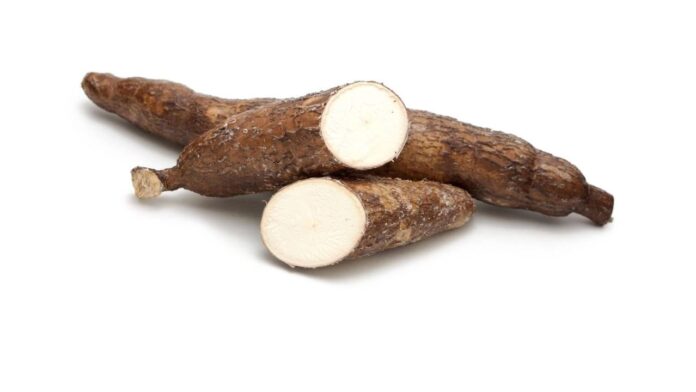Do you know about Cassava Health Risks? Cassava is a staple crop for millions worldwide, but it does come with some health risks if not properly prepared. This starchy root vegetable contains compounds that can generate cyanide if eaten raw or improperly cooked. However, with the right processing and preparation, cassava is safe to eat and provides key nutrients. Read on to learn all about cassava, from health risks to serving sizes and preparation methods to make it safe to enjoy.
Content Highlights
- Cassava naturally contains toxic cyanogenic glycosides, making poorly processed varieties dangerous, even lethal, for consumption.
- With adequate preparation steps—peeling, chopping, soaking, rinsing, and thorough cooking methods like boiling or baking—cassava can be safely enjoyed.
- Properly processed cassava offers nutritional benefits as an excellent carb and vitamin C, B6, calcium and mineral source.
- Check that cassava is not moldy or bitter-tasting, and cook thoroughly until soft, averaging 20–30 minutes, to destroy contaminating toxins prior to consumption.
Cassava, also known as yuca or manioc, is a nutty, starchy root vegetable cultivated in tropical regions of the world. This carb-rich vegetable is a dietary staple for an estimated 800 million people globally thanks to its hardy nature, high yields, and ability to grow in poor soil conditions.
However, raw cassava root naturally contains potentially toxic compounds called cyanogenic glucosides, which can convert into poisonous hydrogen cyanide if eaten. As such, cassava does come with risks if it is not properly prepared before consumption.
Cassava Health Risks from Cyanide
Eating poorly processed cassava can expose you to cyanide poisoning from two cyanogenic glucosides: linamarin and lotaustralin. Consuming even small doses of cyanide over time can lead to conditions like goiter, neurological disorders, or even organ damage or paralysis.
However, if prepared correctly, cassava is safe to eat. The key is removing or reducing the harmful compounds via peeling, soaking, drying, fermenting and thorough cooking.
Effects of Chronic Low-Level Cyanide Exposure
Consuming mildly underprocessed cassava roots, leaves or flour over time can cause:
- Goiter: enlargement of the thyroid gland
- Nerve damage resulting in paralysis or lack of muscle coordination
- Brain conditions like Konzo cause irreversible paralysis.
- Increased risk of developing diabetes or cancer
Acute Cyanide Poisoning
In rare cases, eating very poorly prepared cassava can cause acute cyanide poisoning, leading rapidly to:
- Vomiting, abdominal pain
- Headache, dizziness
- Difficulty breathing
- Convulsions
- Loss of consciousness
- Organ failure, death
So while cassava does pose risks if eaten raw, with proper processing and cooking, it can be enjoyed safely.
Safe Serving Sizes for Cassava
When fully processed and prepared, cassava is safe to eat and provides key nutrients. The FDA does not provide official serving-size guidelines for cassava. But general recommendations suggest:
1/2 cup cooked cassava, about 120–240 g
This serving size equals one starchy carb serving and provides:
- 330-660 calories
- 78-156g carbs
- 4-8g protein
- Negligible fat
As a starchy vegetable similar to potatoes, cassava should be eaten in moderation as part of a balanced diet. Most nutritionists recommend no more than 3-5 servings of starchy carbs daily.
Health Benefits of Properly Prepared Cassava
When made safe for consumption, cassava can provide certain nutritional benefits:
- Excellent source of carbs for energy
- Rich in vitamin C, it boosts immunity.
- Provides vitamin B6, calcium, and potassium.
- High fiber supports healthy digestion.
- Gluten-free
Additionally, cassava forms a major part of the diet for people with food sensitivities as it is one of the least allergy-inducing foods.
How to Prepare Cassava Safely?
Preparing cassava properly is vital to remove toxic elements and make it safe to eat. Steps must be taken at each stage, from buying and storing to processing and cooking to destroy contaminating cyanogens.
Key Tips for Safe Consumption
- Ensure cassava appears healthy, without mold or soft spots.
- Peel off the brown outer skin, which contains more toxins.
- Cut into smaller pieces to enable thorough cooking.
- Soak chopped roots in water for 3+ hours to leach toxins.
- Cook thoroughly by boiling, baking or frying until soft.
- Ferment into products like sour starch or tapioca to detoxify.
- Check for a telltale bitter taste, which indicates remaining toxins.
With the right precautions taken in handling, preparing and cooking cassava to eliminate toxins, it can be enjoyed safely as an excellent source of carbohydrates and key nutrients.
How Do You Incorporate Cassava into Your Diet?
There are many ways to enjoy cassava that harness its absorbent nature and mild flavor once it is safe to eat.
Popular Cassava Dishes and Foods
Cassava leaves and tender shoots can also be eaten after thorough washing and cooking to remove toxins. Interested in trying cassava? Consult African, South American and Caribbean cuisine cookbooks for tasty, safe cassava dish inspiration.
| Dish/Food | Features |
|---|---|
| Boiled/roasted/fried cassava root | Versatile starchy base alternative to potato |
| Cassava flour | Gluten-free baking |
| Tapioca pearls & starch | Puddings, boba tea |
| Cassava cake | Sweet coconut pastry |
| Cassareep | Cassava root extract used as a flavorful cooking sauce |
| Cassava bread | Flatbread |
| Fermented cassava – gari, fufu flour | Used in African cuisines |
Conclusion
While eating poorly prepared cassava can expose you to dangerous levels of poisonous cyanide, proper processing and cooking makes it safe for consumption. In fact, when made non-toxic, cassava is an excellent source of key nutrients and carbohydrates enjoyed regularly by millions globally. Follow the right preparation steps, from thorough peeling, soaking and cooking to eliminating bitterness, prior to eating dishes containing this nutritious and versatile vegetable. Adopting proper handling practices is key to harness the benefits of cassava while avoiding the risks.
Frequently Asked Questions ( FAQs )
What parts of cassava are poisonous?
Raw cassava root, leaves and stems naturally contain potentially toxic cyanogenic glycosides which can generate poisonous cyanide if eaten. However, with thorough processing and cooking, cassava can be detoxified and eaten safely.
Why soak cassava before cooking?
Soaking chopped cassava root for 3+ hours in water helps remove water-soluble cyanogens, reducing toxicity significantly before cooking. This leaching process is key for making cassava safe to eat.
Can you die from eating poorly prepared cassava?
In rare cases, consuming very poorly processed cassava with high levels of cyanogens can cause acute cyanide poisoning leading to convulsions, organ failure and possibly death without immediate medical treatment.
Does boiling remove cyanide from cassava?
Yes, boiling is an effective method for removing cyanide from cassava, especially if done thoroughly for 20-30 minutes after the required soaking. Cooking helps degrade heat-susceptible cyanogenic content in cassava, making it safe for eating.














![Technical Aspects of 844 Area Code in 2024 [Detail Guide] 844 Area Code](https://articleify.com/wp-content/uploads/2024/01/844-Area-Code-150x150.jpg)














